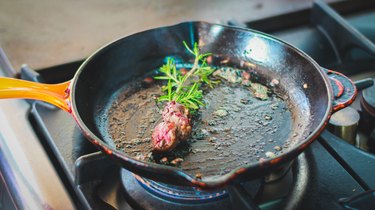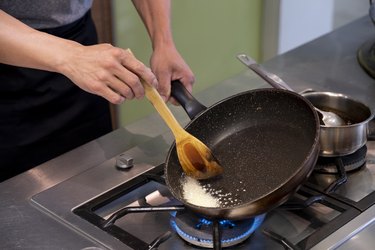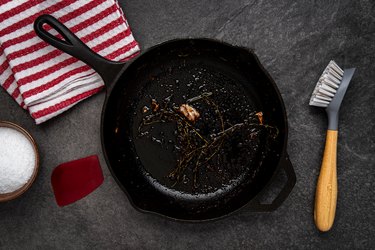
You accept certain consequences when you cook a lot. Peeling and chopping garlic means your hands might smell of it for a day; frying something in a cast iron pan means cleanup might be a little more intensive than it is with other cookware. But cooking with a cast iron pan doesn't mean accepting that your kitchen smoke alarms are going to go off. A cast iron pan only gets super smoky when something is going wrong. Luckily, the common problems have easy solutions.
Cast Iron Smoking While Seasoning
Video of the Day
Seasoning a cast iron pan creates a protective coating of (ideally) several thin layers of oil, which hardens enough to protect the metal from rust and create a nonstick cooking surface. This process involves rubbing a thin layer of oil over the inside of the pan and heating the empty pan at high heat. It's not uncommon to notice your cast iron smoking while seasoning. If you've never seasoned a cast iron pan before, it's possible that you've made a miscalculation somewhere.
Video of the Day
When you notice your cast iron smoking while seasoning, the culprit is probably the oil you used. Every type of oil has its own smoke point, which is the temperature at which the oil will start to smoke. If you season a pan in a 450-degree Fahrenheit oven using coconut oil, which has a smoke point of 350 degrees, you might see smoke develop. Thoroughly wipe out the pan and try again with an oil that has a higher smoke point; corn, safflower, flaxseed and vegetable oils are all well suited for seasoning cast iron.
Using too much oil can also make the hot cast iron pan smoke. There shouldn't be any pooled oil or any noticeably greasy spots; all your pan needs is a very thin sheen of fat to season properly. Soak up any excess oil using a paper towel.
Cast Iron Smoking While Cooking

If it's smoking while you cook with your cast iron pan for the first time – is the pan seasoned? Some brands are sold pre-seasoned, but not all are. An unseasoned pan will often generate a lot of smoke when it's heated for the first time. When this happens, transfer the food to another pan and let the pan cool slightly before cleaning it out and starting the seasoning process.
The pan may also smoke if you're cooking with a dirty pan. Food particles and other cooked-on debris that linger on the cast iron might burn up and smoke when you cook over high heat. Give the pan a deep clean and re-season it before using it again.
If you're cooking with clean, well-seasoned cast iron and the pan is still smoking, the oil or food itself is probably the culprit. Again, cooking with oil that has a low smoke point will create smoke if you're trying to sear something over high heat. Wet foods or foods that release liquid as they cook may create steam or smoke when they hit a hot pan.
Cast Iron Best Practices
A cast iron pan can be used indefinitely and only gets better with age – assuming it's cared for and is properly cleaned after each use. Once your pan is well seasoned, your goal is to protect the nonstick surface you've created. Never soak cast iron in water, which may cause the iron to rust, and never use metal or abrasive brushes to clean the pan.

So what's the right way to care for a seasoned cast iron pan? First, tackle cleanup as soon as the pan is cool enough to handle but is still warm. Use a paper towel to remove cooking oil and food debris. This method is sufficient after you've made something that's fairly dry and not too messy, but if the pan is really dirty, use a little bit of dish soap and a non-abrasive scrubber to wash it under hot water.
Dry cast iron thoroughly right away by placing the pan on a burner set to medium-low heat. Use a paper towel to rub a very thin layer of oil over the pan's cooking surface. After a few minutes, when the pan is completely dry, turn off the burner and let the pan cool before putting it away.